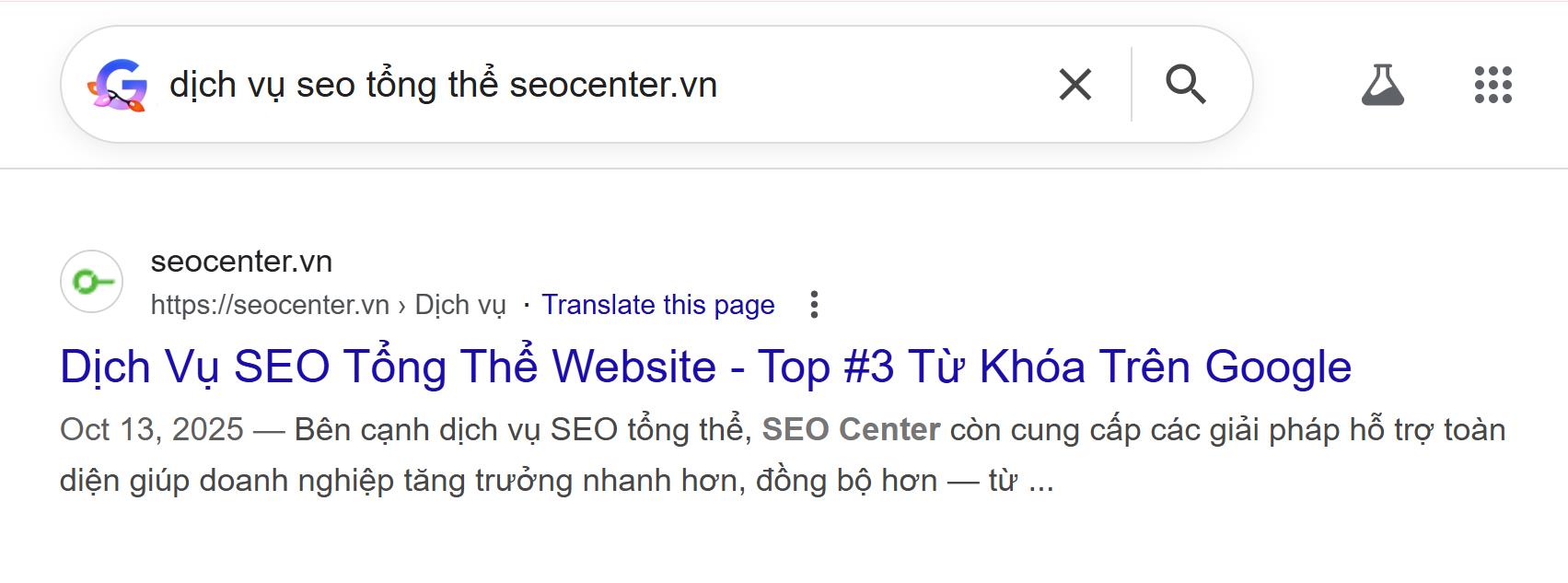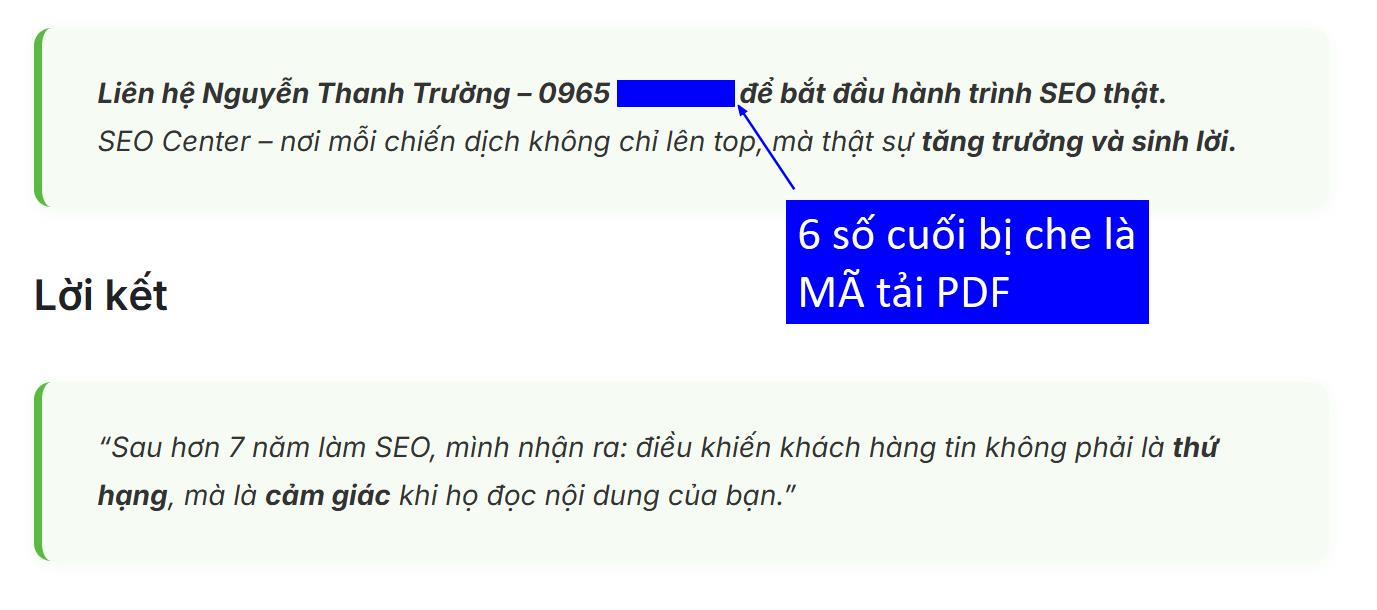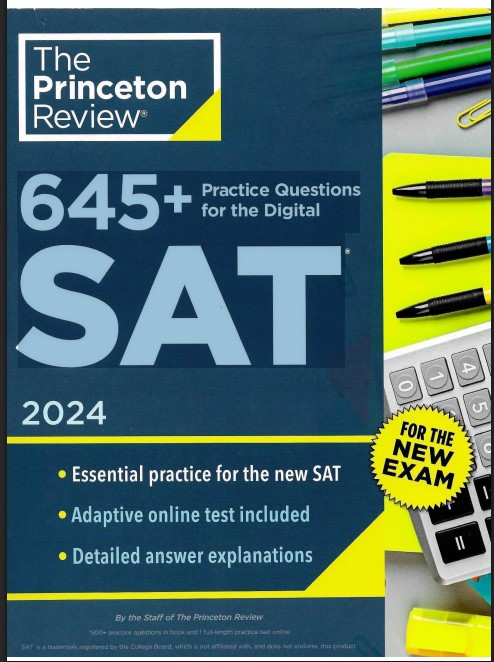
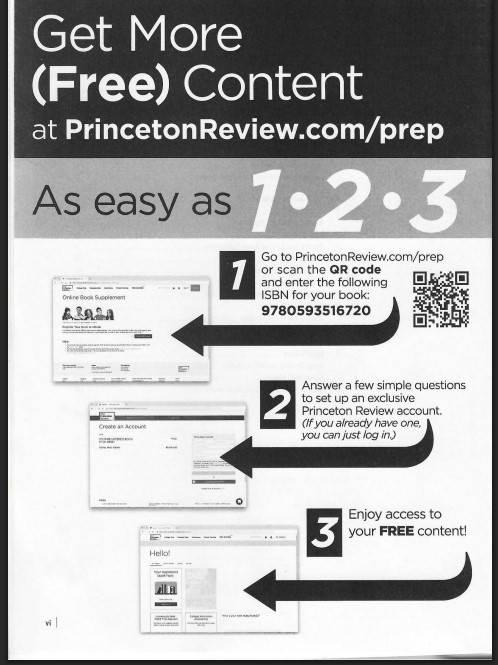
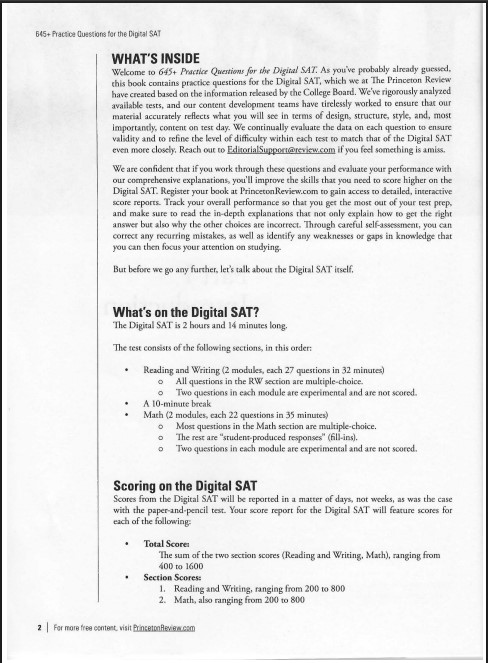
WHAT’S INSIDE
Welcome to 643+ Practice Questions for the Digital SAT, which we at The Princeton Review have created based on the information released by the College Board. We’re rigorously analyzed available tests, and our content development teams have tirelessly worked to ensure that our material accurately reflects what you will see in terms of design, structure, style, and, most importantly, content on test day. We continually evaluate the data on each question to ensure validity and to refine the difficulty level within each test to match that of the Digital SAT even more closely. Reach out to EditorialSupport@review.com if you feel something is amiss.
We are confident that if you work through these questions and evaluate your performance with our comprehensive explanations, you’ll improve the skills that you need to score higher on the Digital SAT. Register your book at PrincetonReview.com to gain access to detailed, interactive score reports. Track your overall performance so that you get the most out of your test prep, and make sure to read the in-depth explanations that not only explain how to get the right answer but also why the other choices are incorrect. Through careful self-assessment, you can correct any recurring mistakes, as well as identify any weaknesses or gaps in knowledge that you can then focus your attention on studying.
But before we go any further, let’s talk about the Digital SAT itself.
What’s on the Digital SAT?
The Digital SAT is 2 hours and 14 minutes long.
The test consists of the following sections, in this order:
- Reading and Writing (2 modules, each 27 questions in 32 minutes)
- All questions in the RW section are multiple-choice.
- Two questions in each module are experimental and are not scored.
- A 10-minute break
- Math (2 modules, each 22 questions in 35 minutes)
- Most questions in the Math section are multiple-choice.
- The rest are “student-produced responses” (fill-ins).
- Two questions in each module are experimental and are not scored.
Scoring on the Digital SAT
Scores from the Digital SAT will be reported in a matter of days, not weeks, as was the case with the paper-and-pencil test. Your score report for the Digital SAT will feature scores for each of the following:
- Total Score:
The sum of the two section scores (Reading and Writing, Math), ranging from 400 to 1600 - Section Scores:
- Reading and Writing, ranging from 200 to 800
- Math, also ranging from 200 to 800
The following table summarizes the structure and scoring of the Digital SAT.
| Category | Digital SAT |
| Time Overall | 134 minutes plus 10-minute break |
| Components | • Reading and Writing section<br>• Math section |
| Number of Questions | • Reading and Writing: 54, including 4 experimental questions<br>• Math: 44, including 4 experimental questions |
| Answer Choices | • Reading and Writing: all multiple-choice with 4 answers per question<br>• Math: 75% multiple-choice with 4 answers per question, 25% student-produced responses |
| Time by Section | • Reading and Writing: 64 minutes in two 32-minute modules<br>• Math: 70 minutes in two 35-minute modules |
| Relationship Between Modules | • Module 1 has a broad mix of levels of difficulty.<br>• Performance on a Module 1 determines the difficulty of Module 2.<br>• Students who do well on Module 1 will get a Module 2 that is harder on average.<br>• Students who do less well on Module 1 will get a Module 2 that is easier on average. |
| Scoring | • The score is based on the number of questions correct and the difficulty of those questions.<br>• There is no penalty for wrong answers or leaving questions blank, so it’s in your best interest to guess rather than leave a question blank.<br>• Students who do well on Module 1 are put into a higher bracket of possible scores.<br>• Students who do less well on Module 1 are put into a lower bracket of possible scores.<br>• Section scores range from 200 to 800.<br>• Total score is the sum of the section scores and ranges from 400 to 1600. |
HOW TO USE THIS BOOK
There are two ways that you can use the content in this book: you can take full-length practice tests or you can focus on honing your skills on specific concepts. You can even do a bit of both.
Most of the questions in this book are laid out as tests in the way that you’ll eventually encounter them on the Digital SAT. Each section (Reading or Writing) begins with a module of mixed difficulty, and your performance on that module determines whether you will get the second module that is easier or harder on average. On the real Digital SAT, you’ll automatically be given an easier or harder second module based on your performance on the first module of each subject. In this book, we’ve included both options for the second module, so if you’d like to take a full test, be sure to follow the guidelines provided at the start of each practice test so that you can mimic the length and difficulty level of the computer-based test as realistically as possible. (For Practice Test 4 in your online student tools, the test will automatically send you to the correct second module in each section.)
Use the paper tests in this book (Practice Tests 1–3) to work on your content knowledge and pace, and when you’re ready to mimic the real digital testing experience, block off about 140 minutes to take Practice Test 4 in your online student tools. If you think you want to discover your areas of strength and weakness before tackling a full test, you can use the Diagnostic Drills that come before Test 1. These drills have a variety of concepts tested on the Digital SAT, and you can use them to warm up to the test or to see where you may need to focus your prep time. Given those insights, you may need to use some of the modules in this book as a source for more questions of those types, rather than as a complete practice test. You can also work on a test module at a time to perfect your pacing. This book also includes a bonus “harder” module for each section, and there is an additional practice test online. Don’t forget to carefully review our detailed explanations! Whether you get a question right or not, its explanation is packed full of our powerful Digital SAT strategies and techniques and might help you to save time on future questions or to clarify where you might have gotten the right answer for the wrong reason.
Calculator use is allowed on all Math questions on the Digital SAT. The testing app includes a built-in Desmos calculator. For the paper tests in this book (Practice Tests 1–3), be sure to use a calculator. For the online-only test in your student tools (Practice Test 4), use our testing app’s built-in calculator.
WHEN YOU TAKE A TEST
Here are some suggestions for working through this book:
- Keep track of your performance. Whether you’re working through individual modules or taking each test as a whole, be sure to use the answer key to score yourself. For the paper tests, you’ll want to do this after each module to so that you can determine which of the two Module 2s to complete. It’s also a good idea to log the time and date of each practice session so that you can track your progress on the in-book Practice Tests 1–3.
- The Digital SAT is a timed test. You may be a star test-taker when you have all the time in the world to mull over the questions, but when the clock is ticking? Timing yourself will ensure you are prepared for the constraints of the actual test, just as our strategy-filled explanations can help you to discover faster methods for solving questions.
- Don’t cram it all in at once. It’s hard enough to concentrate throughout one Digital SAT test—don’t burn yourself out by taking multiple tests in a row. You wouldn’t run two marathons back-to-back, so why treat your brain (which is like a muscle!) in that way? Give yourself at least a couple of months before your anticipated “real” test date so that you can learn from any mistakes that were made on these practice tests.
- Accordingly, take time to analyze your performance between tests or practice modules. As you actively review your work, your mind will be subtly taking notes and tweaking the way it handles future questions of a similar nature, shaving seconds off its processing time as it grows more accustomed to particular wording or presentations.
SAT Prep Test—Reading and Writing
Diagnostic Drills
Turn to Section 1 of your answer sheet to answer the questions in this section.
DIRECTIONS
The questions in this section address a number of important reading and writing skills. Each question includes one or more passages, which may include a table or graph. Read each passage and question carefully, and then choose the best answer to the question based on the passage(s).
All questions in the section are multiple-choice with four answer choices. Each question has a single best answer. Fill in the circle with the answer letter that you think is best.
1 [Mark for Review]
Photo-based artist Deanna Lawson partially her interest in the medium to her upbringing: her mother worked as an administrative assistant at Kodak, a well-known film and camera company, and her father was an employee of Xerox, a company known for its photocopier machines.
Which choice completes the text with the most logical and precise word or phrase?
A. attribute
B. adhere
C. promote
D. inherit
2 [Mark for Review]
Oral tradition is a type of communication method used by a variety of cultures to pass information, art, thoughts, and wisdom between generations. The intelligence can be shared through poetry, folktales, stories, and more and allows cultures to convey these traditions without, or along with, an established writing system. However, the transmission of ideas this way can present certain obstacles. It is difficult to verify whether the knowledge being transferred is correct and similar to its original version. As a result of this, many cultures use devices such as repetition, assonance, alliteration, and rhythmic timing. Through the use of devices like these, it is easier to recall the knowledge in order to correctly relay it to the next generation.
Which choice best states the main purpose of the text?
A. To propose a solution to the obstacles faced by oral tradition
B. To clarify that oral tradition can only be used in certain cultures
C. To explain how cultures make it easier to remember knowledge from oral tradition
D. To assert that oral tradition is more beneficial than a writing system is
3 [Mark for Review]
The following text is from Elizabeth von Arnim’s 1922 novel The Enchanted April. Four women from Dresden have rented an Italian castle for a month’s vacation.
The cook, who had been waiting in increasing agitation in the kitchen, watching the clock getting nearer to lunch-time while she still was without knowledge of what lunch was to consist of, had gone at last to Mrs. Fisher, who had immediately waved her away. She then wandered about the house seeking a mistress, any mistress, who would tell her what to cook, and finding none; and at last, directed by Francesca, who always knew where everybody was, came out to Lady Caroline.
According to the text, why does the cook go to Lady Caroline?
A. The cook wants to express her agitation regarding the condition of the kitchen.
B. The cook wants to determine what she should prepare for lunch.
C. The cook seeks approval for her planned menu.
D. The cook has been sent by Francesca to deliver a message to Lady Caroline.
4 [Mark for Review]
Carbon dioxide emissions are known to have harmful environmental effects. Because the cement industry is one of the biggest producers of carbon dioxide emissions, developing more sustainable processes for manufacturing cement is of major concern. Researchers at Columbia University have developed a method that uses seawater to make cement by converting magnesium ions, which are highly abundant in the oceans, into magnesium hydroxide. According to the researchers, not only does the resulting cement not produce carbon dioxide, but it can actually improve the environment.
Which finding, if true, would most directly support the researchers’ claim?
A. The magnesium-based cement is more energy-intensive than is traditionally made cement.
B. Cement is traditionally produced from carbon rather than magnesium.
C. The magnesium-based cement consumes carbon dioxide.
D. Made cement from seawater is less costly to produce than is cement made from other methods.

